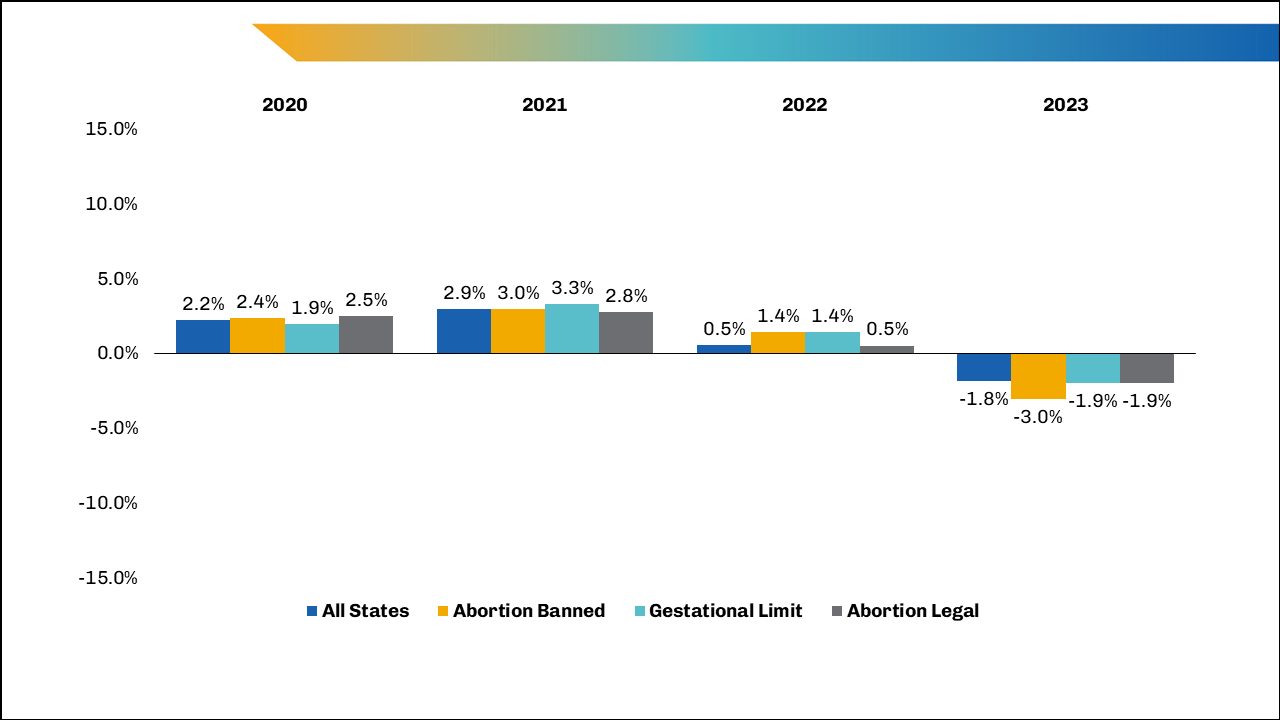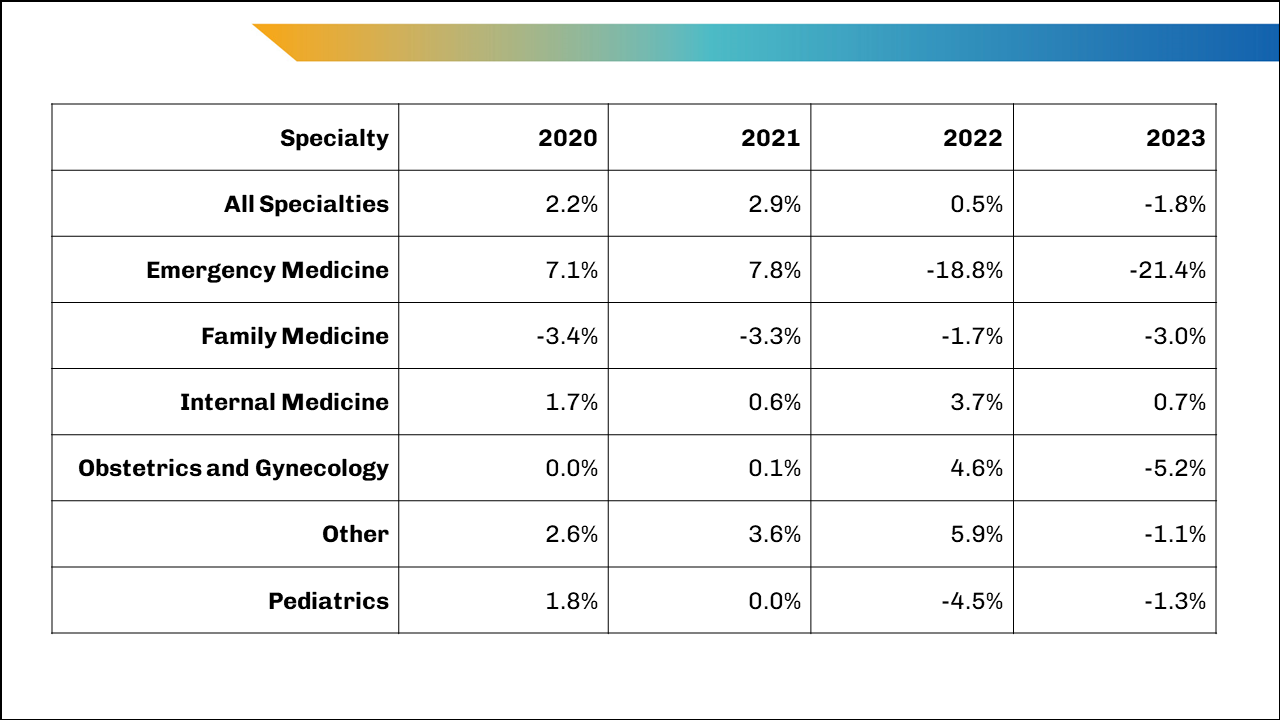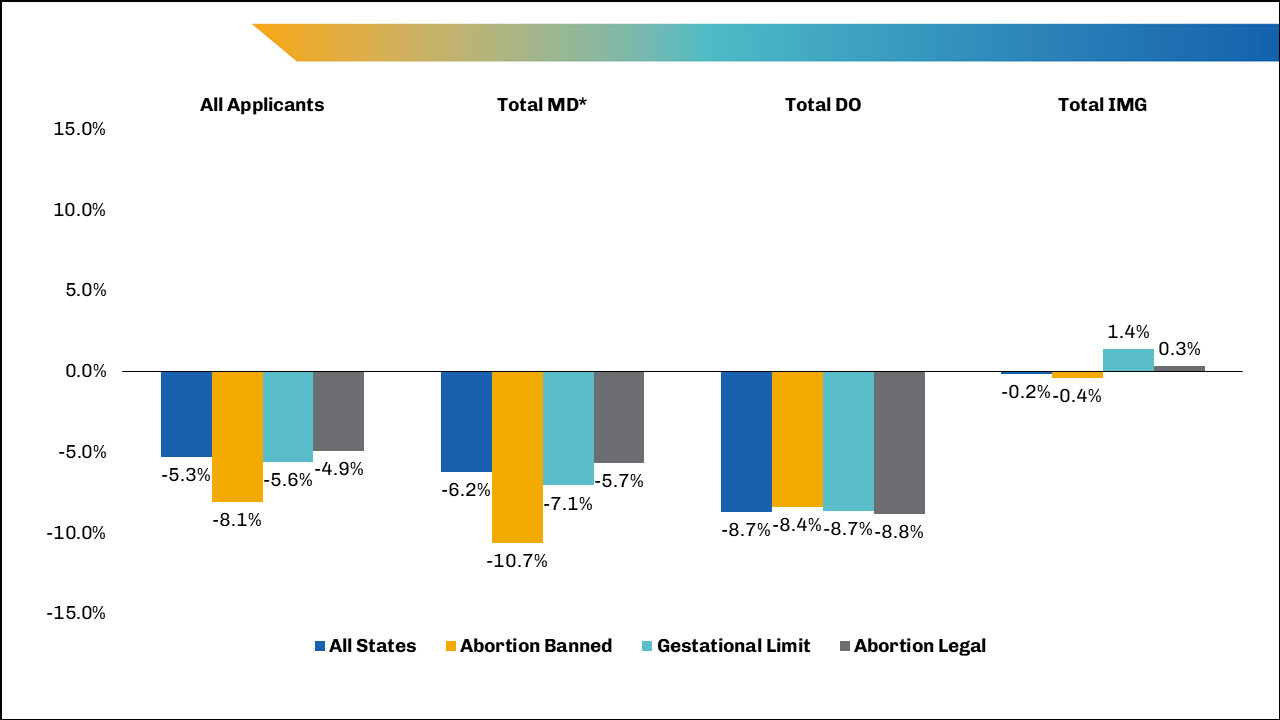For updated data from the most recent ERAS application cycle, See States With Abortion Bans See Continued Decrease in U.S. MD Senior Residency Applicants, published May 9th, 2024.
The U.S. Supreme Court issued its decision on Dobbs v. Jackson Women’s Health Organization in June 2022, just before the submission of residency applications through the Electronic Residency Application Service® (ERAS®), a centralized online application service. Since then, 13 states have enacted full bans on abortion. Because these policy decisions are likely to affect practice-location plans for physicians, state governments and health care leaders need to consider the potential impact of the decisions on the physician workforce. This snapshot examines residency application data by separating states into three cohorts: those with abortion bans, those with gestational limits, and those without gestational limits or abortion bans. While the number of unique medical school graduates, referred to as “U.S. MD seniors,” who applied to programs in all states declined in 2022-2023 from the previous application cycle, states with complete bans saw greater decreases in the number of U.S. MD senior applicants across specialties than states with gestational limits or no restrictions.
The number of U.S. MD seniors who applied to residency positions during the 2022-2023 application cycle1 decreased by about 2% from the previous year. The number of unique U.S. MD senior applicants to states with abortion bans decreased by 3.0%. We focused this analysis on U.S. MD seniors, who historically have the greatest chance of matching into specialties and programs of their choice compared with DO and international medical graduate (IMG) applicants; U.S. MD seniors are likely to be most sensitive to practice and training restrictions in states with total abortion bans or gestational limits on abortion.2
From 2022 to 2023, small decreases were observed in the individual number of applicants across ban status, though decreases were greater among applicants in states with complete bans (Figure 1). States' abortion-ban status is likely correlated with program number and size, but these early findings suggest that applicants may be responding to something independent of program size. In other words, while states with more severe restrictions are often less populous than other states, U.S. MD applicants may be selectively reducing their likelihood of applying to states with more state-imposed restrictions on health care regardless of the number of available residency programs.

Changes in the number of applicants to specialties whose patients are most likely to be affected, including internal medicine, emergency medicine, family medicine, and obstetrics/gynecology, were examined separately. The largest drop in unique applicants across all states was seen in emergency medicine (-21.4%; -376 applicants); a 5.2% (-73 applicants) drop was seen in OB/GYN (Table 1).

Detailed data on OB/GYN residency applications, including program-signaling data for the 2022-2023 cycle, will be analyzed separately. For more information on applicants and applications, visit https://www.aamc.org/data-reports/data/eras-statistics-data.
Similar to the trend seen for all residency applicants, the decrease in unique U.S. MD senior OB/GYN applicants year over year was highest in states with complete bans (-10.5%) and lowest (-5.3%) in states without restrictions (Figure 2). Given the small scale of changes in the number of applicants year to year, there was only a small effect observed in abortion-ban states from 2021-2022 to 2022-2023.
Unique residency applicants are a potentially early and more sensitive indicator of physician interest than other available indicators because the desire to match into a specialty of choice is likely greater than the desire to avoid training in states with major restrictions on reproductive health care. Put simply, applicants are likely to want to match somewhere — even the least desirable location — rather than nowhere. Preliminary examination of one year of data suggests that restrictions on women’s health care may disproportionately decrease the likelihood that U.S. MD seniors will apply for residencies in states with the most restrictive practice environments, although the effect is small.
Despite these changes, all residency positions in OB/GYN were filled this year and with a similar number of U.S. MD seniors as last year.3 Most large specialties also filled at rates similar to previous years, with the exception of emergency medicine (which saw a significant decrease in the number of U.S. MD senior applicants nationwide). Across all applicant types (MD, DO, and IMG), the number of unique OB/GYN applicants decreased slightly (Figure 3).

The total number of residency applications is less likely to decrease due to avoiding particular states for training than is the number of unique applicants; application volume for OB/GYN residency programs will be more closely examined in other publications.
Because these results are of limited use in understanding exactly what may be motivating U.S. MD seniors to disproportionately avoid states with more restrictions on the practice of medicine, it will be critical for future research to explore this relationship further (e.g., looking at change among in- and out-of-state applicants) and for residency and fellowship programs (and state medical boards) to collect information from current and future program graduates about what state they choose to practice in and the reasons for their choice.
Nationally, the number of residency applicants continues to exceed the number of training slots available, so residency programs in states with complete abortion bans may continue to fill their residency programs. However, careful monitoring of workforce data at the program and state levels will be necessary to ensure states with abortion bans continue to attract qualified trainees and physicians in the future.
Methods
All analyses were conducted using Electronic Residency Application Service (ERAS) data from 2019 to 2023. This snapshot examines the changes in the number of individual applicants across application cycles and abortion-ban status; data at the application level were not examined for this analysis. The data are a subset of applicant data as of March 1 each year. The sample population was U.S. MD senior applicants in Figure 1 through Figure 2, and they exclude applicants who attended Canadian schools, IMGs, and DOs.
State abortion-ban status is from KFF as of Jan. 20, 2023, https://www.kff.org/other/state-indicator/abortion-policy-tracker/. States with abortion bans are Alabama, Arkansas, Idaho, Kentucky, Louisiana, Mississippi, Missouri, Oklahoma, South Dakota, Tennessee, Texas, West Virginia, and Wisconsin. States with gestational limits are Arizona, Florida, Georgia, Indiana, Iowa, Kansas, Nebraska, North Carolina, North Dakota, Ohio, South Carolina, and Utah. States where abortion is legal are Alaska, California, Colorado, Connecticut, Delaware, District of Columbia, Hawaii, Illinois, Maine, Maryland, Massachusetts, Michigan, Minnesota, Montana, Nevada, New Hampshire, New Jersey, New Mexico, New York, Oregon, Pennsylvania, Rhode Island, Vermont, Virginia, Washington, and Wyoming.
Notes
- Applicants applied on or very near Sept. 28, 2022, when the abortion laws and bans were still in flux and changing rapidly.
- National Resident Matching Program®, Data Release and Research Committee. Results of the 2022 NRMP Program Director Survey. Washington, DC: National Resident Matching Program; 2022. https://www.nrmp.org/wp-content/uploads/2022/09/PD-Survey-Report-2022_FINALrev.pdf.
- National Resident Matching Program. Advance Data Tables: 2023 Main Residency Match, 2022. https://www.nrmp.org/wp-content/uploads/2023/03/2023-Advance-Data-Tables-FINAL.pdf.



